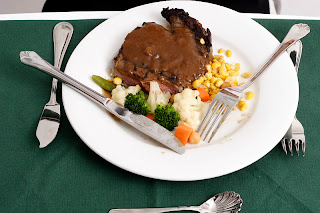
1) All that we teach for corporate Malaysia has to bear significance on the business needs of the organizations. Otherwise, it is just passing on knowledge to be stored and maybe hardly used. The spirit of training is for the learners to take home some practical tips that they can immediately put to use.
2) We received many requests for Western Dining Etiquette, as much as Business Etiquette and Protocol.
3) As most of us would probably know by now, there is a table setting for Western Fine Dining, how to cut and pick up different types of food and so on.
4) Let’s ask ourselves – how fast can our learners pick up the western dining culture unless it is practiced on a daily basis? I don’t think many of our upbringing, traditions and customs are western at all. If that is so, the burning question is, why do we need to learn western dining?
5) Let me offer a 2-prong answer - defining dining for the occasion and applying the dining experience appropriately.
6) First, whether it is Western, Japanese, Indian, Chinese or Russian, it has to be relevant for the current business need. For example, Overseas Posting Programs (OPP) have the dining elements in them depending on which countries the learners are going to be posted to. Or, if an organization has a large number of expatriates from a particular country, we need to cater for that group of high-level executives.

7) In other words, dining etiquette is not meant to be a set of rules to foreign customs and traditions, but rather a guide to demonstrate respect and tolerance of people from different background, culture or custom, whom we deal with on a daily basis.
8) The second prong of my answer is on the definition of fine dining, formal dining, semi-formal dining and casual, and who participate in each of the different categories.
9) For fine dining, we are looking at Carcosa Seri Negara as the setting and environment, usually prepared for important guests and key business associates. You can tell that it is fine dining by just looking at the silverware and silver-service.

10) Formal dining is one rung lower than fine dining; all 5-star hotels should offer that. So do grandiose Chinese or Japanese restaurants. The menu is somewhat a fusion and the silverware feels lighter (to save cost). Most of the times, the F & B staff do not lay out the full set of cutleries and crockery (again, to save cost). And don’t be surprised to find the silver-service falling short of expectation these days.
11) Semi-formal dining is like family dining. Some examples that come to mind are Tony Roma’s, TGIF, Italian restaurants, Overseas Restaurant, Saloma etc. This is good for family and friends, even clients.
12) Casual dining is our everyday staple consumption and patronage. You and I chill out at these places, away from work, bosses and clients, where we can “be our true selves”.
13) We have a 3rd and probably, the essential factor in dining. It is the behavior we portray at the dining table. Many of us would call that “table manners”.
14) How we are supposed to improve on our finesse by just knowing which cutlery to use if the multitude negative behavioral traits that we inadvertently showcase during a formal business luncheon cause distaste amongst our clients (who are polite enough not to tell us) and embarrassment to our organization’s management (who straight-forwardly send us for training).
15) Somehow the writing is on the wall for many, it is really the table mannerism, isn’t it?
Albert CH Lee
First Impressions Group
.jpg)
.jpg)
No comments:
Post a Comment